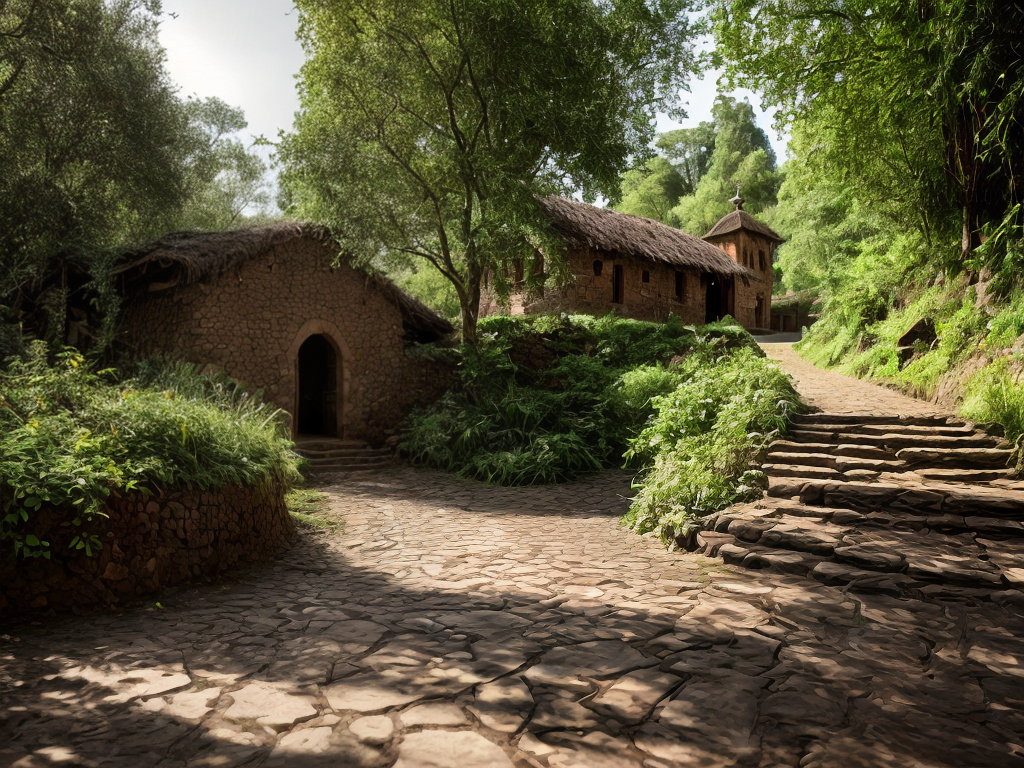Have you ever wondered what it would be like to step back in time and immerse yourself in the rich history of Ethiopia? Well, I can assure you that Cultural Tours in Lalibela offer a truly captivating journey through Ethiopian history. From the enigmatic rock-hewn churches that date back to the 12th century to the vibrant local markets where ancient traditions come to life, Lalibela is a destination that will leave you in awe. But there is so much more to discover in this remarkable place, where the past intertwines with the present in ways that will both surprise and delight you. So, join me as we embark on a journey through Lalibela’s cultural heritage, where every step reveals a fascinating chapter of Ethiopian history.
The Origins of Lalibela’s Rock-Hewn Churches
The origins of Lalibela’s rock-hewn churches can be traced back to the 12th century, when King Lalibela of Ethiopia commissioned their construction as a testament to his faith and a symbol of the nation’s rich religious history. These magnificent structures were carved out of solid rock, using sophisticated construction techniques that have amazed historians and architects for centuries.
The churches were meticulously crafted by skilled artisans, who chipped away at the volcanic tuff rock to create intricate architectural details. The construction process was painstaking and required a high level of precision. The craftsmen used simple tools like hammers and chisels to shape the rock, relying on their expertise to create stunning features such as windows, columns, and arches.
The historical significance of Lalibela’s rock-hewn churches cannot be overstated. They are not only a testament to the religious devotion of King Lalibela, but also a reflection of the enduring faith of the Ethiopian people. These churches have served as places of worship for centuries, attracting pilgrims from near and far.
Moreover, the impact of these rock-hewn churches extends beyond their religious significance. They have become a symbol of Ethiopia’s rich cultural heritage and have played a crucial role in promoting tourism in the region. Visitors from around the world marvel at the architectural marvels, marveling at the skill and craftsmanship of the ancient builders.
Exploring the Iconic Lalibela Monasteries
As I step into the iconic Lalibela monasteries, I am immediately struck by their architectural wonders. These rock-hewn structures, carved out of solid volcanic rock, are a testament to the incredible craftsmanship of the ancient Ethiopian civilization. Beyond their physical beauty, the monasteries hold immense spiritual significance, serving as important centers of worship and pilgrimage for the Ethiopian Orthodox Church. It is truly a unique experience to explore these sacred sites and witness the rich history and cultural heritage they embody.
Architectural Wonders of Lalibela
While exploring the iconic Lalibela Monasteries, one is immediately captivated by the extraordinary architectural wonders that have withstood the test of time. These hidden treasures of Lalibela are true architectural marvels, showcasing the incredible craftsmanship and ingenuity of the ancient Ethiopian builders. Carved out of solid rock, these monolithic churches are not only visually stunning but also hold immense historical and religious significance. The intricate details and intricate carvings on the walls and ceilings, depicting biblical scenes and religious symbols, transport visitors to a different era. The unique design and engineering techniques employed in the construction of these monasteries are a testament to the advanced knowledge and skills of the craftsmen. Exploring these architectural wonders is like stepping into a living museum, where the past comes alive and whispers its secrets to those who listen.
Spiritual Significance of Monasteries
Stepping into the iconic Lalibela Monasteries, one cannot help but feel a profound sense of spiritual significance. These monasteries are not just architectural marvels but also hold deep religious and historical significance. The monasteries are places where spiritual practices are carried out by monks and pilgrims alike. They serve as centers of worship, meditation, and learning for the Ethiopian Orthodox Church. The monasteries are also steeped in historical legends, with stories passed down through generations. Each monastery has its own unique story, adding to the mystical aura that surrounds Lalibela. Exploring these monasteries allows visitors to connect with the rich spiritual heritage of Ethiopia and witness firsthand the devotion and faith that has endured for centuries.
Unique Rock-Hewn Structures
The rock-hewn structures of Lalibela’s iconic monasteries are remarkable examples of architectural ingenuity and religious devotion. These unique structures, carved directly into the solid rock, showcase the unusual architecture of the region and hold great historical significance. Lalibela is home to 11 monolithic churches, each with its own distinct design and purpose. The intricate carvings, intricate arches, and hidden passageways within these structures are a testament to the skill and craftsmanship of the ancient Ethiopian builders. These rock-hewn churches date back to the 12th century and are considered sacred by the Ethiopian Orthodox Church. They serve as important pilgrimage sites and continue to attract visitors from around the world who are fascinated by their historical and cultural importance. Exploring these monasteries offers a unique opportunity to delve into Ethiopian history and experience the spiritual atmosphere that surrounds them.
Unraveling the Mysteries of Lalibela’s Underground Churches
As I ventured into the underground churches of Lalibela, I was amazed by the hidden architectural wonders and the religious significance that I uncovered. These underground churches, carved out of solid rock, are a testament to the incredible skill and craftsmanship of the artisans who built them. The mysteries that surround these sacred spaces only deepen my appreciation for the rich history and spiritual heritage of Lalibela.
Hidden Architectural Wonders
Unveiling the mysteries of Lalibela’s underground churches reveals a hidden world of architectural wonders. These ancient structures, carved out of solid rock, showcase the ingenuity and skill of the craftsmen who built them centuries ago. Here are three hidden architectural techniques that make these churches truly remarkable:
-
Monolithic Construction: Each church is hewn from a single piece of rock, creating a seamless integration with the natural surroundings. The precision and craftsmanship required for such an undertaking is awe-inspiring.
-
Intricate Carvings: The interiors of the churches are adorned with intricate carvings depicting biblical scenes and religious symbols. The level of detail and artistry in these carvings is a testament to the sacredness of the space.
-
Underground Passageways: Connecting the different churches are a network of underground passageways, adding an element of mystery and intrigue to the overall architectural design.
These hidden architectural techniques not only showcase the remarkable skills of the craftsmen, but also hold immense historical significance, reflecting the deep religious devotion and cultural heritage of Lalibela.
Religious Significance Uncovered
Continuing our exploration of Lalibela’s hidden architectural wonders, we now turn our attention to unraveling the mysteries of the underground churches and their religious significance. These subterranean marvels, carved out of solid rock, hold not only the secrets of ancient Ethiopian history but also the unearthing of ancient relics that carry immense cultural value. Stepping into these sacred spaces, one can feel a palpable connection to the past, as centuries-old cultural rituals and practices are still carried out within their hallowed walls. To further immerse ourselves in this experience, let us take a closer look at the religious significance of Lalibela’s underground churches through the following table:
| Ancient Relics | Cultural Rituals and Practices |
|---|---|
| Sacred artifacts dating back centuries | Spiritual ceremonies and prayers |
| Manuscripts written in ancient languages | Pilgrimages and processions |
| Religious icons and symbols | Traditional music and dance |
Unveiling the stories behind these relics and witnessing the vibrant traditions that continue to thrive today, one can truly grasp the enduring spiritual legacy of Lalibela.
The Intricate Architecture of Lalibela’s Cultural Landmarks
Lalibela’s cultural landmarks showcase an intricate architectural marvel that leaves visitors in awe. The unique design and construction of these landmarks reflect the influences on architectural design and the cultural significance of Lalibela’s landmarks. Here are three key aspects of the intricate architecture that make these cultural landmarks truly exceptional:
-
Rock-Hewn Churches: Lalibela is famous for its rock-hewn churches, which are carved out of solid rock. These churches, such as the iconic Church of St. George, are meticulously chiseled out of the surrounding volcanic rock, creating a seamless integration between nature and architecture. The precision and skill required to carve these churches out of solid rock is a testament to the ingenuity of the craftsmen of that time.
-
Monolithic Structures: The monolithic structures in Lalibela, such as the Bete Medhane Alem or the House of the Savior of the World, are single pieces of rock that have been sculpted into magnificent structures. These monolithic churches, some of which are considered the largest monolithic structures in the world, are a testament to the architectural prowess of the medieval Ethiopian civilization.
-
Elaborate Carvings and Reliefs: Lalibela’s cultural landmarks are adorned with intricate carvings and reliefs that depict biblical scenes and religious symbols. These elaborate decorations not only serve an aesthetic purpose but also convey the religious and cultural significance of the landmarks. The craftsmanship and attention to detail in these carvings are truly remarkable, showcasing the artistic skills of the craftsmen of that era.
The intricate architecture of Lalibela’s cultural landmarks is a testament to the rich history and cultural heritage of Ethiopia. Exploring these architectural marvels offers a truly immersive experience that allows visitors to appreciate the skill, ingenuity, and cultural significance behind these remarkable structures.
Discovering Lalibela’s Rich Cultural Traditions
As I explore Lalibela’s rich cultural traditions, I am fascinated by the vibrant cultural festivals that take place in this ancient Ethiopian city. From the famous Timkat festival to the Meskel celebration, these events offer a glimpse into the deep-rooted traditions and religious practices of the local community. Additionally, Lalibela’s traditional crafts and art showcase the incredible skills and craftsmanship of the people, with intricate carvings, paintings, and textiles that narrate the region’s history and cultural heritage.
Cultural Festivals in Lalibela
Every year, Lalibela comes alive with vibrant cultural festivals that showcase the rich traditions of this Ethiopian city. These cultural celebrations offer a unique opportunity to immerse oneself in the local culture and experience the true essence of Lalibela. Here are three reasons why these festivals are a must-see:
-
Traditional Music: Lalibela’s festivals are known for their captivating traditional music performances. The rhythmic beats and enchanting melodies transport you to a different era, giving you a glimpse into the city’s musical heritage.
-
Colorful Processions: During these festivals, the streets of Lalibela are filled with vibrant processions. Locals dressed in traditional attire, carrying ornate umbrellas and crosses, march through the city, creating a spectacle that is both visually stunning and culturally significant.
-
Sacred Ceremonies: Many of the festivals in Lalibela are deeply rooted in religious traditions. Witnessing these sacred ceremonies, such as the blessing of the churches or the lighting of candles, allows you to gain a deeper understanding of the religious practices that have shaped the city’s history.
Attending these cultural festivals in Lalibela is a truly immersive experience that allows you to connect with the city’s rich cultural heritage on a profound level.
Traditional Crafts and Art
Immersing myself in the vibrant cultural festivals of Lalibela, I couldn’t help but be captivated by the traditional crafts and art that beautifully showcase the rich cultural traditions of this Ethiopian city. Lalibela is renowned for its exquisite traditional crafts, which are deeply rooted in the region’s artistic traditions. Skilled artisans create intricate wood carvings, hand-woven textiles, and delicate pottery that reflect the city’s unique cultural heritage. The wood carvings, in particular, are a prominent feature of Lalibela’s artistic traditions. Artisans meticulously carve religious symbols, geometric patterns, and scenes from Ethiopian folklore into wooden objects, such as crosses and religious icons. These traditional crafts not only serve as decorative pieces but also carry deep symbolic and cultural significance, preserving the history and traditions of Lalibela for generations to come.
Immersing Yourself in Lalibela’s Vibrant Festivals
What makes Lalibela’s festivals so vibrant and captivating? It’s the perfect blend of traditional dances, cultural cuisine, and a lively atmosphere that draws you in and keeps you wanting more. Here are three reasons why Lalibela’s festivals are an immersive experience like no other:
-
Enchanting Traditional Dances: Get ready to be mesmerized by the vibrant traditional dances that are an integral part of Lalibela’s festivals. From the rhythmic movements to the colorful costumes, these dances showcase the rich cultural heritage of the region. You’ll find yourself swaying to the beat and feeling the energy of the performers as they tell stories through their graceful movements.
-
Delicious Cultural Cuisine: Food plays a significant role in Ethiopian culture, and Lalibela’s festivals are no exception. Indulge in a feast of flavors as you savor the mouthwatering dishes prepared with local ingredients and traditional cooking techniques. From injera, a spongy flatbread, to doro wat, a spicy chicken stew, the culinary delights of Lalibela will leave you craving for more.
-
A Vibrant Atmosphere: Lalibela’s festivals are a celebration of community, unity, and joy. The air is filled with the sounds of music, laughter, and cheers as locals and visitors come together to partake in the festivities. From the colorful decorations adorning the streets to the lively conversations and laughter that fill the air, the vibrant atmosphere of Lalibela’s festivals will leave an indelible mark on your heart.
Immersing yourself in Lalibela’s vibrant festivals is an opportunity to experience the rich cultural traditions, indulge in delicious cuisine, and connect with the local community. It’s an intimate journey through Ethiopian history that will leave you with memories to cherish for a lifetime.
Exploring the Sacred Artifacts of Lalibela’s Churches
As I explore the vibrant festivals of Lalibela, I am drawn to the sacred artifacts found within the town’s churches. Lalibela is home to 11 monolithic rock-hewn churches, each one a masterpiece of architecture and religious significance. These churches are not only places of worship but also storehouses of ancient artifacts that hold immense historical and cultural value.
To truly understand the rich heritage of Lalibela, I embarked on a journey to explore the hidden chambers of these churches. The intricate carvings and paintings that adorn the walls transport me back in time, offering a glimpse into the lives of the devout worshippers who created and used these sacred spaces.
One of the most fascinating aspects of my exploration is witnessing the ancient religious rituals that still take place within these churches. The chants, prayers, and ceremonial processions provide a window into the spiritual practices that have been preserved for centuries. It is a humbling experience to witness the continuity of these traditions and to feel a part of something much larger than myself.
Within the hidden chambers, I discover an array of sacred artifacts, ranging from ornate crosses and religious manuscripts to ancient textiles and intricate religious icons. Each artifact tells a story, representing the faith and devotion of the Ethiopian people throughout the ages.
As I delve deeper into the exploration of Lalibela’s churches, I come to appreciate the profound connection between these sacred artifacts and the religious practices that have shaped the town’s identity. It is a privilege to witness and be a part of this living history, and I am grateful for the opportunity to explore the hidden chambers and experience the ancient religious rituals that continue to thrive in Lalibela.
Experiencing the Spiritual Practices of Lalibela’s Monks
As I immersed myself in the cultural journey of Lalibela, I had the opportunity to witness the monastic rituals and traditions practiced by the monks. These spiritual practices hold great significance in Lalibela, as they are deeply rooted in the history and traditions of the Ethiopian Orthodox Church. The monk-led experiences provided a unique and profound insight into the spiritual world of Lalibela, allowing me to gain a deeper understanding of its religious heritage.
Monastic Rituals and Traditions
I was fascinated by the spiritual practices of Lalibela’s monks as I experienced the monastic rituals and traditions firsthand. Here are three aspects that stood out to me:
-
Chanting and Prayers: The rhythmic chants and melodic prayers filled the air, creating a serene and sacred atmosphere. The monks’ harmonious voices resonated with a deep sense of devotion and spirituality, transporting me to a higher state of consciousness.
-
Iconography and Symbolism: The monastic rituals in Lalibela are rich in symbolism. Intricate murals and vibrant frescoes adorned the walls, depicting biblical scenes and religious figures. The monks explained the significance of each image, allowing me to appreciate the depth of Ethiopian Christian iconography.
-
Sacred Ceremonies: Witnessing the monks perform sacred ceremonies was a truly captivating experience. From the lighting of candles to the swinging of censers, every action was imbued with reverence. These rituals, passed down through generations, offer a glimpse into the preserved cultural traditions of Lalibela’s monastic community.
Spiritual Significance of Lalibela
Experiencing the spiritual practices of Lalibela’s monks unveils the profound spiritual significance that permeates this historic Ethiopian site. Lalibela is home to ancient traditions that have been passed down through generations, creating a unique and deeply spiritual atmosphere. The monks, dressed in traditional white robes, engage in a variety of spiritual practices that are central to their way of life. From chanting ancient prayers to performing rituals and ceremonies, these practices connect the monks to their faith and the rich history of Lalibela. Observing these rituals firsthand allows visitors to gain a deeper understanding of the spiritual essence of this sacred place. It is a humbling and awe-inspiring experience to witness the monks’ dedication and devotion to their beliefs, making Lalibela a truly special destination for spiritual seekers.
Immersive Monk-Led Experiences
Visitors to Lalibela can partake in immersive monk-led experiences, delving deep into the spiritual practices that define this historic Ethiopian site. These cultural immersion experiences offer a unique opportunity to connect with the rich traditions of the local monks and gain a deeper understanding of their way of life. Here are three reasons why you should consider participating in a monk-led experience in Lalibela:
-
Insight into Monk Led Traditions: Through these experiences, you will have the chance to witness and learn about the ancient rituals, chants, and prayers that have been passed down from generation to generation. This firsthand encounter with the monk-led traditions will provide a glimpse into the spiritual essence of Lalibela.
-
Authentic Cultural Immersion: By engaging with the monks, you will have the chance to immerse yourself in the daily life of the monastery. From observing their meditation practices to participating in communal meals, you will gain a deeper appreciation for the unique cultural heritage of Lalibela.
-
Spiritual Renewal: The serene and tranquil environment of Lalibela, coupled with the guidance and teachings of the monks, offers a perfect setting for spiritual reflection and renewal. Whether you are seeking a personal retreat or a transformative experience, the monk-led activities will help you connect with your inner self and find moments of peace and tranquility.
Join us in Lalibela for an unforgettable journey of cultural exploration and spiritual discovery through these immersive monk-led experiences.
Unveiling Lalibela’s Historical Connection to King Lalibela
The historical connection between King Lalibela and the magnificent rock-hewn churches in Lalibela is a captivating tale of religious devotion and architectural brilliance. Lalibela, a 12th-century Ethiopian king, is believed to have been divinely inspired to create these astonishing structures. During my visit to Lalibela, I had the incredible opportunity to uncover the historical artifacts and explore the ancient rituals that are deeply intertwined with King Lalibela’s legacy.
As I delved into the history of Lalibela, I discovered that King Lalibela wanted to create a “New Jerusalem” in Ethiopia, as the land was inaccessible to Christians due to Muslim conquests. He aimed to establish a pilgrimage site that would offer spiritual solace and religious significance to his people. To achieve this ambitious vision, King Lalibela commissioned the construction of eleven monolithic churches, each carved out of solid rock.
These rock-hewn churches are not only architectural marvels but also hold immense religious importance for Ethiopian Orthodox Christians. The churches are intricately adorned with religious symbols, biblical figures, and stunning frescoes that depict scenes from the Bible. Exploring these ancient rituals and witnessing the devotion of the local community was truly awe-inspiring.
Unveiling the historical artifacts that have been preserved within the rock-hewn churches was an experience that transported me back in time. From ancient manuscripts to intricate crosses and religious relics, these artifacts provide a glimpse into the rich cultural heritage of Lalibela and its connection to King Lalibela.
Visiting Lalibela offers a unique opportunity to delve into the fascinating history of King Lalibela and his architectural masterpieces. It is a journey that not only allows you to witness the breathtaking beauty of these rock-hewn churches but also offers a deeper understanding of the historical and religious significance that they hold.
Delving Into the Ancient Legends of Lalibela
Delving into the ancient legends of Lalibela reveals a captivating world of mythical tales and spiritual wonders. As I explore the hidden treasures of this ancient Ethiopian city, I am transported back in time, immersed in the rich folklore that has shaped Lalibela’s history. Here are three intriguing legends that add an enchanting layer to this already remarkable destination:
-
The Legend of the Angels: According to local belief, the 11 rock-hewn churches of Lalibela were not built by human hands, but by angels. It is said that King Lalibela, inspired by a divine vision, summoned heavenly beings to aid in the construction of these sacred sites. The intricate details and sheer magnitude of the churches lend credence to this myth, leaving visitors in awe of the supernatural.
-
The Legend of the Bet Giyorgis Church: This iconic structure, shaped like a cross and carved entirely from solid rock, holds a captivating legend. It is said that King Lalibela challenged the builders of the church to complete its construction within one night. To their surprise, the angels joined forces with the human workers, and by morning, the church stood in all its glory. This tale not only showcases the ingenuity of the builders but also highlights the profound spiritual connection between Lalibela and the divine.
-
The Legend of the Holy Water: Lalibela is known for its holy water, believed to possess miraculous healing properties. Legend has it that this water is connected to the River Jordan in Israel, further underscoring the city’s spiritual significance. Pilgrims from all over the world come to Lalibela to drink from its sacred wells, seeking physical and spiritual healing.
Delving into these ancient legends allows us to understand the deep-rooted traditions and beliefs that have shaped Lalibela over centuries. Exploring these hidden treasures not only offers a glimpse into the past but also invites us to contemplate the enduring power of faith and mythology.
The Significance of Lalibela’s Crosses and Carvings
As I further explore Lalibela’s captivating world of ancient legends and spiritual wonders, the intricate crosses and carvings found throughout the city hold immense significance and offer a glimpse into the profound religious heritage of this Ethiopian gem. These symbolic artworks serve as powerful reminders of the deep spirituality and devotion of the people who built and worshipped in the rock-hewn churches of Lalibela.
The crosses, meticulously carved from solid stone, are not merely decorative elements but are considered sacred objects. They are symbols of faith, representing the crucifixion of Jesus Christ and the salvation he brought to humanity. Each cross tells a unique story, with intricate patterns and designs that reflect the rich cultural history of Ethiopia. These crosses are not only religious artifacts but also works of art, showcasing the exceptional craftsmanship of the artisans who created them.
Carvings, on the other hand, are found both inside and outside the churches, depicting biblical scenes and saints. They serve as visual narratives, bringing to life the stories and teachings of the Bible. These carvings not only convey religious messages but also offer a glimpse into the daily lives and traditions of the people of Lalibela. The attention to detail in these carvings is remarkable, with every stroke and curve telling a story and conveying a message.
The significance of Lalibela’s crosses and carvings goes beyond their artistic beauty. They are powerful symbols of faith, connecting the present-day visitors to the ancient roots of Ethiopian Christianity. They offer a profound insight into the religious beliefs and practices of the people who built these remarkable churches. Exploring Lalibela’s crosses and carvings is an intimate journey into the heart of Ethiopian spirituality and a testament to the enduring power of faith throughout history.
The Influence of Lalibela on Ethiopian Christianity
Lalibela’s impact on Ethiopian Christianity is profound and far-reaching, shaping the religious practices and beliefs of the nation. Here are three ways in which Lalibela has influenced Ethiopian Christianity:
-
Influence of Lalibela’s architecture: The rock-hewn churches of Lalibela are a testament to the devotion and ingenuity of the Ethiopian people. These remarkable structures, carved out of solid rock, serve as a physical manifestation of faith. The unique architectural style of Lalibela has influenced the construction of churches across Ethiopia, with many churches incorporating elements of its design. This influence can be seen in the use of monolithic pillars, intricate carvings, and the overall layout of Ethiopian churches.
-
Lalibela’s religious pilgrimage: Lalibela is not just a place of worship, but also a destination for religious pilgrimage. Every year, thousands of Ethiopian Orthodox Christians make the journey to Lalibela to celebrate religious festivals and pay homage to the holy sites. This pilgrimage is an important part of Ethiopian Christian tradition and reinforces the significance of Lalibela in the religious life of the country. The pilgrimage experience offers a sense of spiritual connection and communal devotion, bringing Ethiopians closer to their faith.
-
Preservation of ancient religious practices: Lalibela has played a crucial role in preserving ancient religious practices that date back centuries. The rituals, chants, and ceremonies performed in Lalibela’s churches have been passed down through generations, ensuring the continuation of Ethiopian Christian traditions. The spiritual atmosphere of Lalibela provides a space for believers to connect with their religious heritage and deepen their faith.
Understanding the Preservation Efforts in Lalibela
To understand the preservation efforts in Lalibela, it is important to recognize the ongoing commitment to safeguarding the historic site and its cultural significance. Lalibela is not just a collection of ancient rock-hewn churches; it is a testament to the rich cultural heritage of Ethiopia and a symbol of its historical and religious importance. The preservation efforts in Lalibela aim to protect and maintain the integrity of these remarkable structures, ensuring that future generations can continue to appreciate their beauty and historical significance.
One of the key aspects of the preservation efforts in Lalibela is the implementation of conservation measures. These measures include the use of specialized techniques and materials to repair and restore the churches, as well as ongoing monitoring to identify any potential threats or damage. Additionally, strict regulations and guidelines have been put in place to ensure that any interventions or modifications to the churches are done in a way that respects their historical and cultural significance.
Another important aspect of the preservation efforts is community involvement. The local community plays a vital role in the preservation and maintenance of Lalibela. They are actively involved in the conservation efforts, including participating in training programs and workshops on preservation techniques. This community-driven approach not only fosters a sense of ownership and pride but also ensures the long-term sustainability of the preservation efforts.
Furthermore, the preservation efforts in Lalibela are supported by national and international organizations. These organizations provide technical expertise, funding, and resources to support the conservation projects. Their involvement showcases the global recognition of the cultural heritage value of Lalibela and the importance of its preservation.
Experiencing the Local Life in Lalibela’s Markets
What makes Lalibela’s markets a unique experience for visitors? When exploring Lalibela, one cannot miss the vibrant and bustling markets that offer a fascinating glimpse into the local life and culture. Here are three reasons why experiencing the local life in Lalibela’s markets is a must:
-
Experiencing Traditional Cuisine: The markets of Lalibela are a treasure trove of traditional Ethiopian cuisine. As you walk through the stalls, the aroma of freshly roasted coffee, spices, and injera (a sourdough flatbread) fills the air. You can sample a variety of delicious dishes such as doro wat (chicken stew), kitfo (minced raw meat), and tibs (grilled meat). Engaging with the local vendors and trying their authentic recipes provides a unique culinary experience.
-
Traditional Music Performances: Lalibela’s markets are not only about shopping and food; they also offer a chance to immerse yourself in the rich musical heritage of Ethiopia. You may come across talented musicians playing traditional instruments like the krar (a string instrument) or the masenqo (a single-stringed bowed lute). Their soulful melodies will transport you to a different era and give you a deeper appreciation for Ethiopian music.
-
Dance Performances: In addition to the enchanting music, Lalibela’s markets often feature traditional dance performances. Local dancers adorned in vibrant traditional attire gracefully move to the rhythm of the music, showcasing the cultural traditions and storytelling through their movements. Watching these captivating performances is an opportunity to witness the beauty and grace of Ethiopian dance.
Visiting Lalibela’s markets allows you to engage with the local community, appreciate their traditional cuisine, and witness their vibrant music and dance. The authenticity and intimacy of these experiences make Lalibela’s markets an unforgettable part of any cultural tour.
The Impact of Lalibela’s Cultural Heritage on Ethiopia
After experiencing the vibrant markets and cultural traditions in Lalibela, it is evident that the town’s cultural heritage has had a profound impact on Ethiopia. Lalibela’s rich history and architectural wonders have attracted tourists from all over the world, contributing significantly to the country’s tourism industry. The ancient rock-hewn churches, dating back to the 12th century, are not only religious sites but also architectural marvels that showcase Ethiopia’s cultural and artistic heritage.
The impact of Lalibela’s cultural heritage on tourism cannot be overstated. The town’s unique and awe-inspiring churches draw visitors who are captivated by their intricate designs, religious significance, and historical importance. As a result, tourism in Lalibela has flourished, providing employment opportunities for the local community and boosting the economy. The influx of tourists has also spurred the development of hotels, restaurants, and other infrastructure to accommodate the growing number of visitors.
Moreover, Lalibela’s cultural heritage plays a crucial role in preserving Ethiopia’s history and identity. The rock-hewn churches are not only important religious sites for Ethiopian Orthodox Christians but also serve as a testament to the country’s ancient civilization and architectural prowess. By showcasing these cultural treasures to the world, Lalibela helps to raise awareness and appreciation for Ethiopia’s rich heritage, fostering a sense of pride and cultural preservation among its people.







